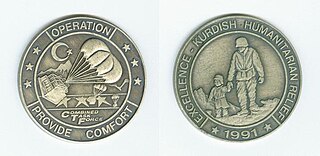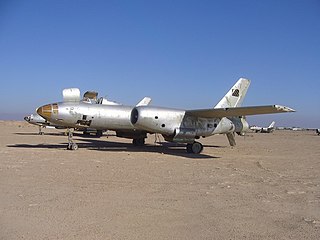
The McDonnell Douglas F-15 Eagle is an American twin-engine, all-weather fighter aircraft designed by McDonnell Douglas. Following reviews of proposals, the United States Air Force (USAF) selected McDonnell Douglas's design in 1969 to meet the service's need for a dedicated air superiority fighter. The Eagle took its maiden flight in July 1972, and entered service in 1976. It is among the most successful modern fighters, with over 100 victories and no losses in aerial combat, with the majority of the kills by the Israeli Air Force.

The Lockheed F-117 Nighthawk is a retired American single-seat, subsonic twin-engine stealth attack aircraft developed by Lockheed's secretive Skunk Works division and operated by the United States Air Force (USAF). It was the first operational aircraft to be designed with stealth technology.

The Iraqi no-fly zones conflict was a low-level conflict in the two no-fly zones (NFZs) in Iraq that were proclaimed by the United States, United Kingdom, and France after the Gulf War of 1991. The United States stated that the NFZs were intended to protect the ethnic Kurdish minority in northern Iraq and Shiite Muslims in the south. Iraqi aircraft were forbidden from flying inside the zones. The policy was enforced by the United States and the United Kingdom until 2003, when it was rendered obsolete by the 2003 invasion of Iraq. French aircraft patrols also participated until France withdrew in 1996.

The Panavia Tornado Air Defence Variant (ADV) is a long-range, twin-engine swing-wing interceptor aircraft developed by the European Panavia Aircraft GmbH consortium. It was a specialised derivative of the multirole Panavia Tornado.

The Mikoyan-Gurevich MiG-25 is a supersonic interceptor and reconnaissance aircraft that is among the fastest military aircraft to enter service. Designed by the Soviet Union's Mikoyan-Gurevich bureau, it is an aircraft built primarily using stainless steel. It was to be the last plane designed by Mikhail Gurevich, before his retirement.

Operation Provide Comfort and Provide Comfort II were military operations initiated by the United States and other Coalition nations of the Persian Gulf War, starting in April 1991, to defend Kurdish refugees fleeing their homes in northern Iraq in the aftermath of the Gulf War, and to deliver humanitarian aid to them. The no-fly zone instituted to help bring this about would become one of the main factors allowing the development of the autonomous Kurdistan Region.

The McDonnell DouglasF-15E Strike Eagle is an American all-weather multirole strike fighter derived from the McDonnell Douglas F-15 Eagle. The F-15E was designed in the 1980s for long-range, high-speed interdiction without relying on escort or electronic-warfare aircraft. United States Air Force (USAF) F-15E Strike Eagles can be generally distinguished from other US Eagle variants by darker aircraft camouflage, conformal fuel tanks (CFTs) mounted along the engine intake ramps and a tandem-seat cockpit.

Suppression of Enemy Air Defenses (SEAD, pronounced ), also known in the United States as "Wild Weasel" and (initially) "Iron Hand" operations, are military actions to suppress enemy surface-based air defenses, including not only surface-to-air missiles (SAMs) and anti-aircraft artillery (AAA) but also interrelated systems such as early-warning radar and command, control and communication (C3) functions, while also marking other targets to be destroyed by an air strike. Suppression can be accomplished both by physically destroying the systems or by disrupting and deceiving them through electronic warfare. In modern warfare, SEAD missions can constitute as much as 30% of all sorties launched in the first week of combat and continue at a reduced rate through the rest of a campaign. One quarter of American combat sorties in recent conflicts have been SEAD missions. Despite generally being associated with aircraft, SEAD missions may be performed using any means, including through actions by ground forces.

The Iraqi Air Force is the aerial warfare service branch of the Iraqi Armed Forces. It is responsible for the defense of Iraqi airspace as well as the policing of its international borders. The IQAF also acts as a support force for the Iraqi Navy and the Iraqi Army, which allows Iraq to rapidly deploy its military. It is headquartered in Baghdad; the current commander is Lieutenant Gen. Shihab Jahid Ali.

The history of the Iranian Air Force, currently known as the Islamic Republic of Iran Air Force, can be divided into two phases—before the Islamic Revolution, and after it.

Strike Fighter Squadron 154 (VFA-154), also known as the "Black Knights", is a United States Navy strike fighter squadron stationed at Naval Air Station Lemoore. The Black Knights are an operational fleet squadron flying the F/A-18F Super Hornet. They are currently attached to Carrier Air Wing Eleven and deployed aboard the aircraft carrier USS Theodore Roosevelt. Their tailcode is NH and their callsign is "Knight".

Operation Southern Watch was an air-centric military operation conducted by the United States Department of Defense from August 1992 to March 2003.

Operation Desert Storm, the combat phase of the Gulf War, began with an extensive aerial bombing campaign by the air forces of the coalition against targets in Iraq and Iraqi-occupied Kuwait from 17 January 1991 to 23 February 1991. Spearheaded by the United States, the coalition flew over 100,000 sorties, dropping 88,500 tons of bombs, widely destroying military and civilian infrastructure. The air campaign was commanded by United States Air Force (USAF) Lieutenant General Chuck Horner, who briefly served as Commander-in-Chief—Forward of U.S. Central Command while General Norman Schwarzkopf was still in the United States. The British air commanders were Air Chief Marshal Andrew Wilson and Air Vice-Marshal Bill Wratten. The air campaign had largely finished by 23 February 1991 with the beginning of the coalition ground offensive into Kuwait.
During the 1991 Gulf War and subsequent operations in no-fly zones over Iraq, Coalition air forces faced the Iraqi Air Force (IQAF), the fourth largest air force in the world at the time. In the opening days of the war, many air-to-air engagements occurred, between Iraqi interceptors and a variety of different Coalition aircraft.

Al Taqaddum Airbase or Al Taqaddum AB, called TQ in military shorthand slang, is an air base that is located in central Iraq, approximately 74 kilometers west of Baghdad, at Habbaniyah. The airfield is served by two runways 13,000 and 12,000 feet (3,700 m) long. Since 2004, it has been known as Camp Taqaddum. It was formerly known as Tammuz Airbase.

Shaibah Air Base is an Iraqi Air Force airfield in the Basrah Governorate of Iraq.

The H-3 airstrike was a surprise air attack by the Iranian Air Force during the Iran–Iraq War on 4 April 1981 against the Iraqi Air Force's H-3 Air Base in western Iraq. The Iranians destroyed at least 48 Iraqi aircraft on the ground with no losses of their own. Based on the results achieved, it is considered one of the most successful raids in the history of aerial warfare.
Operation Samurra was an operation by the Iraqi Air Force (IQAF) during the Gulf War to decisively engage McDonnell Douglas F-15C Eagle fighters from the United States Air Force (USAF) using Mikoyan-Gurevich MiG-25 interceptors, and break the "wall" of F-15s that the Coalition had established along Iraq's border with Iran. It demonstrated the last true offensive operation of the IQAF before grounding their air assets in an attempt to preserve them for future use. Through careful planning and coordination, two MiG-25 jets successfully caught two USAF F-15 fighters, of the 53rd Tactical Fighter Squadron out of Al Kharj Air Base, off guard and engaged them in a dogfight.
The attack on Ras Tanura was an attempted aerial bombing of the Ras Tanura oil production facility in Saudi Arabia during the Gulf War. Employing Dassault Mirage F1 fighters loaded with incendiary bombs, and two Mikoyan-Gurevich MiG-23s as fighter cover, Iraq intended to demonstrate to the coalition that it was capable of offensive air actions. Although the aircraft penetrated well into Saudi airspace due to skilled flying and luck, both bombers were shot down before they could reach their target by a McDonnell Douglas F-15C Eagle of the Royal Saudi Air Force after their fighter cover fled.

During January 1993, numerous coalition airstrikes occurred against Iraq in response to actions by the latter predominantly due to the No-Fly Zone in Southern Iraq.

















